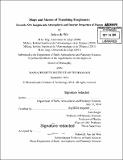| dc.contributor.advisor | Sara Seager. | en_US |
| dc.contributor.author | De Wit, Julien | en_US |
| dc.contributor.other | Massachusetts Institute of Technology. Department of Earth, Atmospheric, and Planetary Sciences. | en_US |
| dc.coverage.spatial | zs----- | en_US |
| dc.date.accessioned | 2015-02-25T17:09:40Z | |
| dc.date.available | 2015-02-25T17:09:40Z | |
| dc.date.copyright | 2014 | en_US |
| dc.date.issued | 2014 | en_US |
| dc.identifier.uri | http://hdl.handle.net/1721.1/95554 | |
| dc.description | Thesis: Ph. D. in Planetary Sciences, Massachusetts Institute of Technology, Department of Earth, Atmospheric, and Planetary Sciences, 2014. | en_US |
| dc.description | Cataloged from PDF version of thesis. | en_US |
| dc.description | Includes bibliographical references (pages 183-200). | en_US |
| dc.description.abstract | With over 1800 planets discovered outside of the Solar System in the past two decades, the field of exoplanetology has broadened our perspective on planetary systems. Research priorities are now moving from planet detection to planet characterization. In this context, transiting exoplanets-planets that cross in front of their star from our point-of-view-are of special interest due to the wealth of data made available by their orbital configuration. In this thesis, I introduce two methods, and their Markov chain Monte Carlo implementations, to gain new insights into the atmospheric and interior properties of exoplanets. The first method aims to map an exoplanet's atmosphere based on the eclipse scanning which is obtained while a planet is occulted by its host star. Ultimately temperature, composition, and circulation patterns could be constrained in three-dimensions from these maps, a significant asset for informing atmospheric models. I introduce the basics of eclipse mapping, its caveats (particularly, the correlation between the planet's shape, brightness distribution, and four system parameters), and a framework to mitigate the caveats' effects via global analyses including transits, phase curves, and radial velocity measurements. I use this method to create the first two-dimensional map and the first cloud map of an exoplanet for the hot-Jupiters HD 189733b and Kepler-7b, respectively. The second method, MassSpec, aims to determine transiting planet masses and atmospheric properties solely from transmission spectra, i.e. the starlight filtered by a planet's atmosphere during transits. Determination of an exoplanet's mass is key to understanding its basic properties, including its potential for supporting life. To date, mass constraints for exoplanets are predominantly based on radial velocity measurements, which are not suited for planets with low masses, large semi-major axes, or those orbiting faint or active stars. I demonstrate that a planet's mass has to be accounted for by atmospheric retrieval methods to ensure unbiased estimates of atmospheric properties. Utilizing MassSpec, the James Webb Space Telescope (launch date: 2018) could determine the mass and atmospheric properties of half a dozen Earth-sized planets in their host's habitable zones over its lifetime, which could lead to the first identification of a habitable exoplanet. | en_US |
| dc.description.statementofresponsibility | by Julien de Wit. | en_US |
| dc.format.extent | 200 pages | en_US |
| dc.language.iso | eng | en_US |
| dc.publisher | Massachusetts Institute of Technology | en_US |
| dc.rights | M.I.T. theses are protected by copyright. They may be viewed from this source for any purpose, but reproduction or distribution in any format is prohibited without written permission. See provided URL for inquiries about permission. | en_US |
| dc.rights.uri | http://dspace.mit.edu/handle/1721.1/7582 | en_US |
| dc.subject | Earth, Atmospheric, and Planetary Sciences. | en_US |
| dc.title | Maps and masses of transiting exoplanets : towards new insights into atmospheric and interior properties of planets | en_US |
| dc.title.alternative | Towards new insights into atmospheric and interior properties of planets | en_US |
| dc.type | Thesis | en_US |
| dc.description.degree | Ph. D. in Planetary Sciences | en_US |
| dc.contributor.department | Massachusetts Institute of Technology. Department of Earth, Atmospheric, and Planetary Sciences | |
| dc.identifier.oclc | 903532737 | en_US |
